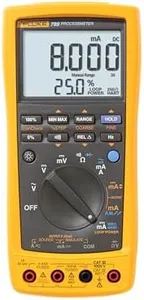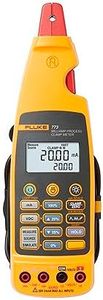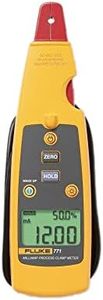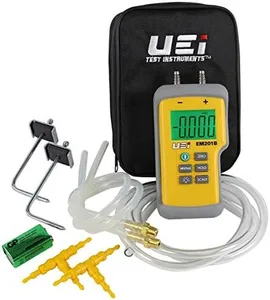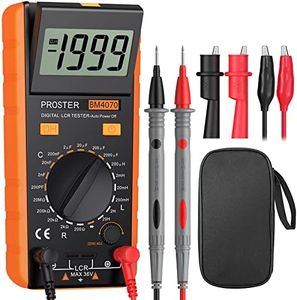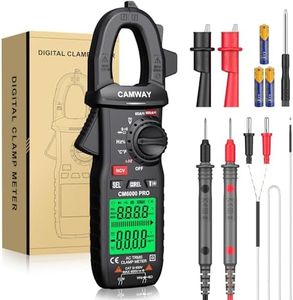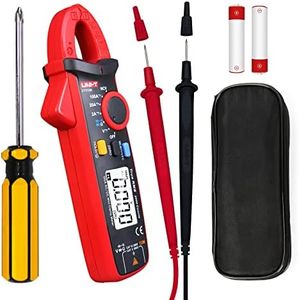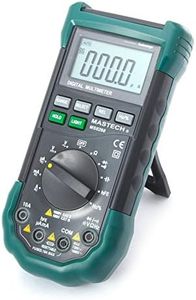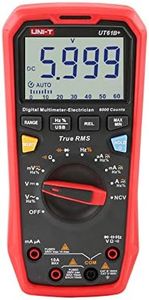10 Best Process Multimeters 2025 in the United States
Our technology thoroughly searches through the online shopping world, reviewing hundreds of sites. We then process and analyze this information, updating in real-time to bring you the latest top-rated products. This way, you always get the best and most current options available.

Our Top Picks
Winner
Fluke 789 ProcessMeter, Includes Standard DMM Capabilities, Measure, Source, Simulate 4-20 mA signals, and Built-In 24 V Loop Supply
The Fluke 789 ProcessMeter is a versatile tool designed for professionals who need a combination of digital multimeter (DMM) capabilities and process control features. It excels in accuracy with its ability to measure and source 4-20 mA signals, which is essential for process control applications. The resolution and range are suitable for most industrial tasks, with a current measurement range of 0 to 30 mA DC. With a 1000V overload protection on various functions and a built-in 24V loop supply, it ensures safety and robust performance in demanding environments.
The built-in, selectable 250-Ohm Hart resistor is a valuable feature for process control applications. The safety ratings are reinforced by the 440 mA 1000V fuse, which protects the device from high-voltage spikes. Additional features like the clear LCD display with backlight, auto step, auto ramp, and quick span check buttons enhance usability. The device runs on a 9-volt alkaline battery, offering around 50 hours of typical measurement use, though it has a shorter battery life of 12 hours when sourcing 12 mA.
Weighing 1.34 pounds, it is relatively lightweight and portable. The Fluke 789 is best suited for industrial professionals who need reliable and precise measurement and simulation capabilities in process control. However, it might be overkill for casual users or those who do not require advanced process control features.
Fluke 773 Advanced Milliamp Process Clamp-Meter
Most important from
39 reviews
The Fluke 773 Advanced Milliamp Process Clamp-Meter is designed for professionals needing precise measurements of 4-20 mA signals, typically used in PLC and control system analog I/O. One of its standout features is the ability to measure these signals without breaking the loop, which significantly reduces downtime and simplifies testing procedures.
Its compact size and detachable clamp with an extension cable make it ideal for use in tight spaces, and the built-in spotlight is a thoughtful addition for working in poorly lit conditions. The device boasts a best-in-class accuracy of 0.2%, ensuring reliable and precise readings, a crucial factor for maintaining system accuracy and performance.
Additionally, it operates on 4 AA alkaline batteries, which are included, making it ready for immediate use out of the box. The Fluke 773 is also lightweight, weighing only 0.41 kilograms, which enhances its portability. The device's high accuracy, ease of use, and practical features make it a valuable tool for professionals in the process control industry.
Most important from
39 reviews
Fluke 771 Milliamp Process Clamp Meter
Most important from
51 reviews
The Fluke 771 Milliamp Process Clamp Meter stands out for its excellent accuracy of 0.2%, which is crucial for precise measurements in process control applications. Its resolution of 0.01 mA allows for detecting very subtle changes in current, making it highly sensitive and suitable for fine adjustments, especially in PLC and control system analog I/O.
The ability to measure 4 to 20 mA signals without breaking the loop is a significant advantage, as it simplifies the process and reduces downtime in industrial environments. Additionally, the dual backlit display that shows both mA measurement and percent of 4 to 20 mA span is user-friendly and enhances readability in different lighting conditions.
Weighing only 300 grams and powered by 2 AA batteries, it is portable and easy to handle during fieldwork. The Fluke 771 is a reliable tool for professionals who require accurate and efficient mA signal measurements in process control applications.


